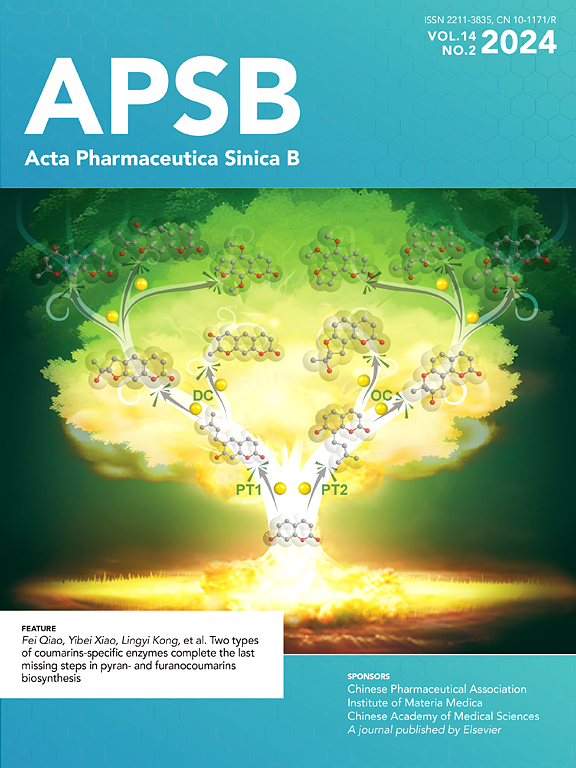Phenotypic screening uncovered anti-myocardial fibrosis candidates using a novel 3D myocardial tissue under hypoxia
IF 14.6
1区 医学
Q1 PHARMACOLOGY & PHARMACY
引用次数: 0
Abstract
Myocardial fibrosis (MF) is a common pathological hallmark of cardiovascular diseases, reflecting shared mechanisms in their progression. However, the lack of reliable MF models that accurately mimic its pathogenesis has hindered drug discovery, highlighting the urgent need for more effective therapeutic agents. Herein, a novel contractile three-dimensional (3D) myocardial tissue model integrating cardiomyocytes, cardiac-fibroblasts, and bone marrow-derived macrophages in collagen hydrogel was developed to simulate the fibrotic changes of cardiovascular disease, and facilitate the screening of anti-MF compounds. The 3D myocardial tissue model exhibited precise, visualizable, and quantifiable contractile characteristics under hypoxia and drug interventions. 76 compounds extracted from the resins of Toxicodendron vernicifluum, a traditional Chinese medicine with clear clinical benefits for fibrotic diseases, were screened for anti-fibrotic activity. Using an in vitro 3D oxygen–glucose deprivation (OGD)-treated myocardial tissue model instead of a two-dimensional transforming growth factor-β treated cardiac-fibroblasts model, two candidates including LQ-40 and SQ-3 exert impressive anti-MF activity, which was further validated in left anterior descending coronary artery ligation-induced MF mouse model. The current results demonstrate the feasibility and advantage of the novel contractile 3D tissue model with multi-cell types in discovering candidates for MF, further stressing the great potential of regulating macrophages in the treatment of MF.

表型筛选发现抗心肌纤维化候选人使用新的3D心肌组织缺氧
心肌纤维化(MF)是心血管疾病的常见病理标志,反映了心血管疾病进展的共同机制。然而,缺乏准确模拟其发病机制的可靠MF模型阻碍了药物的发现,这突出表明迫切需要更有效的治疗药物。本文建立了一种新型的可收缩的三维(3D)心肌组织模型,将心肌细胞、心肌成纤维细胞和骨髓源性巨噬细胞整合在胶原水凝胶中,以模拟心血管疾病的纤维化变化,并促进抗mf化合物的筛选。在缺氧和药物干预下,三维心肌组织模型显示出精确、可视化和可量化的收缩特征。对临床对纤维化疾病有明显疗效的中药白桦树脂中提取的76个化合物进行了抗纤维化活性筛选。用体外3D氧葡萄糖剥夺(OGD)处理的心肌组织模型代替二维转化生长因子-β处理的心肌成纤维细胞模型,LQ-40和SQ-3两种候选物表现出明显的抗MF活性,并在左冠状动脉前降支结扎诱导的MF小鼠模型中得到进一步验证。目前的研究结果证明了新型多细胞类型的可收缩3D组织模型在寻找MF候选药物方面的可行性和优势,进一步强调了调节巨噬细胞在MF治疗中的巨大潜力。
本文章由计算机程序翻译,如有差异,请以英文原文为准。
求助全文
约1分钟内获得全文
求助全文
来源期刊

Acta Pharmaceutica Sinica. B
Pharmacology, Toxicology and Pharmaceutics-General Pharmacology, Toxicology and Pharmaceutics
CiteScore
22.40
自引率
5.50%
发文量
1051
审稿时长
19 weeks
期刊介绍:
The Journal of the Institute of Materia Medica, Chinese Academy of Medical Sciences, and the Chinese Pharmaceutical Association oversees the peer review process for Acta Pharmaceutica Sinica. B (APSB).
Published monthly in English, APSB is dedicated to disseminating significant original research articles, rapid communications, and high-quality reviews that highlight recent advances across various pharmaceutical sciences domains. These encompass pharmacology, pharmaceutics, medicinal chemistry, natural products, pharmacognosy, pharmaceutical analysis, and pharmacokinetics.
A part of the Acta Pharmaceutica Sinica series, established in 1953 and indexed in prominent databases like Chemical Abstracts, Index Medicus, SciFinder Scholar, Biological Abstracts, International Pharmaceutical Abstracts, Cambridge Scientific Abstracts, and Current Bibliography on Science and Technology, APSB is sponsored by the Institute of Materia Medica, Chinese Academy of Medical Sciences, and the Chinese Pharmaceutical Association. Its production and hosting are facilitated by Elsevier B.V. This collaborative effort ensures APSB's commitment to delivering valuable contributions to the pharmaceutical sciences community.
 求助内容:
求助内容: 应助结果提醒方式:
应助结果提醒方式:


